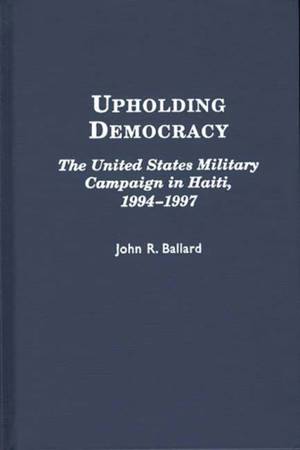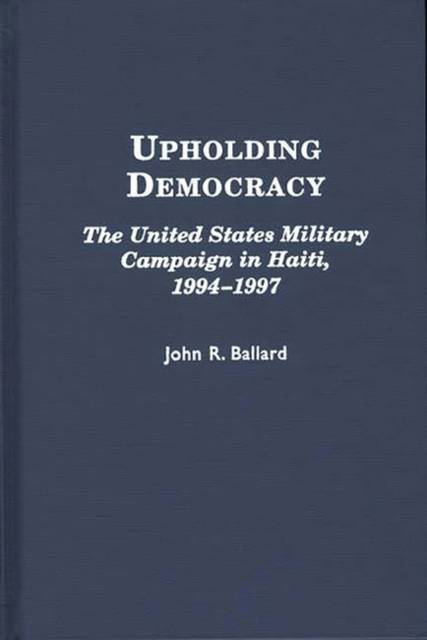
Je cadeautjes zeker op tijd in huis hebben voor de feestdagen? Kom langs in onze winkels en vind het perfecte geschenk!
- Afhalen na 1 uur in een winkel met voorraad
- Gratis thuislevering in België vanaf € 30
- Ruim aanbod met 7 miljoen producten
Je cadeautjes zeker op tijd in huis hebben voor de feestdagen? Kom langs in onze winkels en vind het perfecte geschenk!
- Afhalen na 1 uur in een winkel met voorraad
- Gratis thuislevering in België vanaf € 30
- Ruim aanbod met 7 miljoen producten
Zoeken
Upholding Democracy
The United States Military Campaign in Haiti, 1994-1997
John Ballard
Hardcover | Engels
€ 161,45
+ 322 punten
Omschrijving
An inside account of the U.S. military operation to restore Haitian President Jean-Bertrand Aristide to power in 1994, this study demonstrates progress made in joint warfighting in the period following the end of the Cold War, including improvements in command and control, joint force integration, and techniques for successful humanitarian operations.^L With ties to Haiti that date back over one hundred years, the United States could not stand by as a coup ousted Aristide in 1990. When the coup leaders refused to leave peacefully, forces authorized by the U.N. Security Council deployed toward Haiti. Diplomatic efforts by former President Carter, General Powell, and Senator Nunn eventually obtained the cooperation of coup leaders in the final hour, and on September 19, 1994, the first of over 50,000 U.S. military personnel arrived to ensure security, facilitate Aristide's return, and professionalize the Haitian security forces.^L General Henry Shelton, later the Chairman of the Joint Chiefs of Staff, commanded the joint task force that entered Haiti under Chapter 7 of the U.N. Charter during one of the few recent instances of U.N. intervention without the concurrence of the host nation. While the operation was unique, its innovations will benefit planners for decades as humanitarian actions around the world continue to be important. This book illustrates the challenges of remaining engaged in support of the United Nations and of conducting modern military operations, which are highly dependent on close interagency and multinational coordination.
Specificaties
Betrokkenen
- Auteur(s):
- Uitgeverij:
Inhoud
- Aantal bladzijden:
- 292
- Taal:
- Engels
Eigenschappen
- Productcode (EAN):
- 9780275962371
- Verschijningsdatum:
- 20/08/1998
- Uitvoering:
- Hardcover
- Formaat:
- Genaaid
- Afmetingen:
- 164 mm x 243 mm
- Gewicht:
- 653 g

Alleen bij Standaard Boekhandel
+ 322 punten op je klantenkaart van Standaard Boekhandel
Beoordelingen
We publiceren alleen reviews die voldoen aan de voorwaarden voor reviews. Bekijk onze voorwaarden voor reviews.









